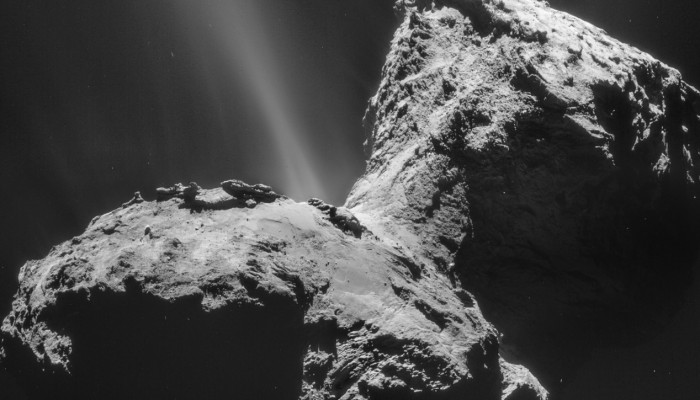
Late last year the Rosetta’s Plasma Consortium (RPC) announced that Comet 67P/Churyumov-Gerasimenko, which the European Space Agency’s Rosetta spacecraft has been studying since August 2014, was singing into space. Now, in a paper published today in the EGU’s open access journal Annales Geophysicae, the RPC team reveals more details about 67P’s song, including why the comet was singing.
The sounds ‘emitted’ by 67P are oscillations in the magnetic field around the comet. Its space environment is permeated by the solar wind – a continuous stream of electrically charged gas (called plasma) and magnetic field lines stringed along from the Sun – which interacts with the comet’s gas-dust atmosphere. A consequence of this interaction is an ‘induced cometary magnetosphere’. In other words, even though the nucleus of 67P has no magnetic field of its own (as announced at this year’s EGU General Assembly), the comet’s atmosphere or coma is magnetised.
As reported in Annales Geophysicae, the RCP magnetometer on board Rosetta started to detect large-amplitude fluctuations in this magnetic field on arrival of the spacecraft at the comet on 6 August 2014. For four months, until November 2014, the RPC team detected about 3000 cases of wave activity with frequencies of about 40 millihertz.
“This is exciting because it is completely new to us. We did not expect this and we are still working to understand the physics of what is happening,” said RPC principal investigator Karl-Heinz Glassmeier at the time ESA reported the discovery of the ‘singing comet’ waves on the Rosetta blog. Glassmeier is head of Space Physics and Space Sensorics at the Technische Universität Braunschweig, Germany, and the senior author of the Annales Geophysicae paper.
This observation took the team somewhat by surprise because it is the first detection of waves of this nature at a comet. In previous cometary encounters, such as the International Cometary Explorer and Sakigake spacecraft flybys of comets Giacobini-Zinner and Halley, researchers measured wave activity with frequencies some 10 times lower.
The difference in the 67P case is that, as Rosetta travelled alongside the comet, the instruments could measure the magnetic field for a long time, and while the comet was still relatively far away from the Sun. The RPC instruments collected the data reported in the new study while the comet was between 400 to 540 million kilometres away from the Sun. At this point, the comet’s activity was low: it was not expelling a lot of gas and dust into space, and the ‘induced magnetosphere’ was just beginning to form.
Since the song 67P sings at this early stage is very different from the ‘classical sounds’ detected at comets closer to the Sun, the team concluded a new mechanism must generate the 40 millihertz waves. (If you are interested in finding out more about the difference between the two types of cometary sounds, and the processes that generate them, read the extra information at the end of this post.)
When RPC scientists first uncovered 67P’s mysterious song, they suspected it had something to do with the comet’s activity – even if low – and the neutral particles it releases into space. Ultraviolet radiation from the Sun causes ionisation of these atoms and molecules, including water molecules. In the plasma environment around the comet’s nucleus, the newborn ions move perpendicularly to the magnetic field, forming what is called a cross-field electric current. It turns out that this current is unstable, and ultimately, it is what makes the comet sing.

Schematic of the processes that generate the singing comet waves. Credit: Karl-Heinz Glassmeier (comet inset credit: ESA/Rosetta)
“The physical process is somewhat difficult to understand without a deeper understanding of plasma physics, but we can use a simple analogy to have a better idea of what’s going on,” says Glassmeier. “Consider your garden hose. If you start the water flow, there is a chance that the hose starts to oscillate, generating waves. This is about what happens in the plasma. Of course, the flow we have in the cometary situation is not like water, but is a flow of charged particles. But somehow the analogy is suitable.”
The questions left to answer are whether 67P continues to sing the same song as it gets closer to the Sun, and whether it starts emitting more classical cometary sounds.
Glassmeier says RPC instruments detected the 40 millihertz waves at least until February this year, when Rosetta was about 350 million kilometres away from the Sun. “Around this time, the activity is changing, other features show up, the plasma interaction region becomes much more violent. Singing comet waves are still present, but buried under a variety of other features we are currently trying to understand.”
“Whether we also observe the classical type of cometary waves, like those observed at Halley, is very difficult to judge. We are heavily working on further analysing the dynamics of this region to find out more.”
By Bárbara Ferreira, EGU Media and Communications Manager
References:
- Richter, I., Koenders, C., Auster, H.-U., et al.,: Observation of a new type of low-frequency waves at comet 67P/Churyumov-Gerasimenko, Ann. Geophys., 33, 1031-1036, doi:10.5194/angeo-33-1031-2015, 2015.
- The singing comet, Rosetta blog, European Space Agency, 11 November 2014
—
Extra: A more detailed explanation of the difference between classical cometary waves and the ‘singing comet’ waves, by Karl-Heinz Glassmeier:
Plasma waves play a most important role in coupling newborn ions of cometary origin with the solar wind plasma. As the particle density of the solar wind is rather small, the interplanetary space is almost a vacuum. There are no collisions between solar wind particles and the cometary ions causing the required coupling. Without such a coupling the cometary ions would move relative to and undisturbed by the solar wind. However, if the comet-solar wind interaction region is much larger than a typical gyro-radius of a cometary ion, as in the case of comet Halley, cometary ions constitute so-called ring-beam distributions in the phase space of the solar wind plasma. Such distributions are heavily unstable and produce the classical cometary waves as observed at Halley and Giacobini-Zinner. These waves, on the other hand, are able to scatter cometary ions as the electric field fluctuations of the waves impact the ion motion. In this way the plasma waves couple the solar wind particles and the cometary ions. The waves act as a kind of mediator between solar wind and cometary ions. A more detailed treatment shows that the frequency of the waves as observed in the spacecraft frame of reference is very close to the local gyrofrequency of the cometary ions. [Editor’s note: Recall that, in the presence of a uniform magnetic field, an electrically charged particle moves in a circular motion; the radius of this circle is the gyro or Larmor radius, and the angular frequency is called gyrofrequency.]
The situation we observed at Chury in the first months after the arrival at the comet is rather different. The interaction region is rather small because of the weak activity of the nucleus. Actually, the size of the interaction region is much less than the gyro-radius of a cometary ion.
I like to call this region the Larmor sphere of the comet. Within the Larmor sphere the newborn ions have not yet been able to perform a complete gyro motion around the solar wind magnetic field. The newborn ions just constitute an electric current perpendicular to both the solar wind flow and magnetic field. This cross-field current is much different from any ring-beam phase space situation observed in case of the large interaction region of Halley or Giacobini-Zinner. In our model, the cross-field current constitutes the very first effect the newborn ions impose onto the ambient plasma. Only later, the newborn ions develop into ring-beam type particle distributions. But in these later stages the plasma volume with the new-born ions have already passed the nucleus, moving downstream.
It is this fundamental difference between the fully developed ring-beam situation at strongly outgassing comets and the cross-field current situation at weakly active comets. In the former case the unstable phase space distribution is moving with the solar wind plasma, while in the latter case the cross-field current is almost fixed with respect to the nucleus.
—


